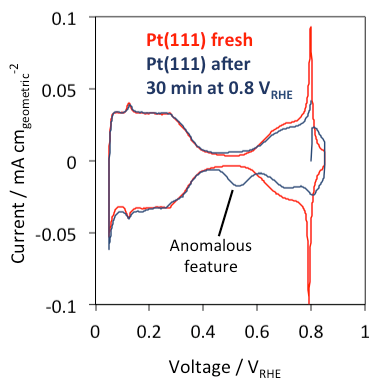(589h) Ptoh Induced Strain on Pt(111) during Chronoamperometry between 0.6 and 1.1 VRHE: Influence on the Pt(111) Interface and Catalytic Reactivity
AIChE Annual Meeting
2022
2022 Annual Meeting
Engineering Sciences and Fundamentals
Interfacial Phenomena in Electrochemical and Electrokinetic Systems
Thursday, November 17, 2022 - 9:45am to 10:00am
An anomalous reduction feature at ~0.53 VRHE was observed on a Pt(111) single crystal in Ar-saturated HClO4 after holding at the fuel-cell relevant voltage of 0.8 VRHE (Figure 1). Decades of research has established that Pt(111) in HClO4 oxidizes H2O to adsorbed *OH between 0.6 and 1.0 VRHE [2-4] and this current model is unable to explain the anomalous feature. Using a combination of computational, electrochemical, spectroscopic, and imaging probes, we find that chronoamperometry at voltages between 0.6 and 1.0 VRHE results in a mildly-roughened Pt(111) surface [5], presumably due to an *OH-induced release of surface stress. The catalytic performance of this mildly roughened Pt(111) was tested for the oxygen reduction reaction (ORR) and carbon monoxide oxidation (CO Oxidation) where it was found that the ORR rate is seemingly structure insensitive and CO Oxidation rate is surprisingly structure sensitive. Overall, this discovery demonstrates the importance of understanding how dynamic and steady operating conditions influence the electrode-electrolyte interface.
References
1. The Hydrogen and Fuel Cell Technologies Office Multi-Year Research, Development, and Demonstration (MYRD&D) Plan, Section 3.4 Fuel Cells, S. Dep. Energy. (2017).
2. Al Jaaf-Golze, D.M. Kolb, D. Scherson, J. Electroanal. Chem. 200 (1986) 353–362.
3. T.M. Koper, J.J. Lukkien, Surf. Sci. 498 (2002) 105–115.
4. H. Kristoffersen, K. Chan, T. Vegge, H.A. Hansen, Chem. Commun. 56 (2020) 427–430.
5. Komanicky, K.C. Chang, A. Menzel, N.M. Marković, H. You, X. Wang, D. Myers, J. Electrochem. Soc. 15 (2006) B446–B451.
